
In mathematics, a prototile is one of the shapes of a tile in a tessellation.

A tessellation or tiling is the covering of a surface, often a plane, using one or more geometric shapes, called tiles, with no overlaps and no gaps. In mathematics, tessellation can be generalized to higher dimensions and a variety of geometries.

An aperiodic tiling is a non-periodic tiling with the additional property that it does not contain arbitrarily large periodic regions or patches. A set of tile-types is aperiodic if copies of these tiles can form only non-periodic tilings.
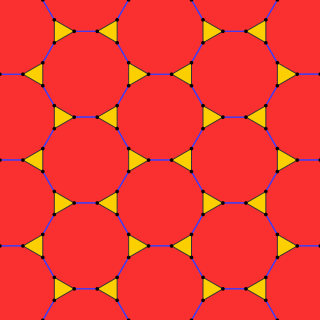
In geometry, the truncated hexagonal tiling is a semiregular tiling of the Euclidean plane. There are 2 dodecagons (12-sides) and one triangle on each vertex.
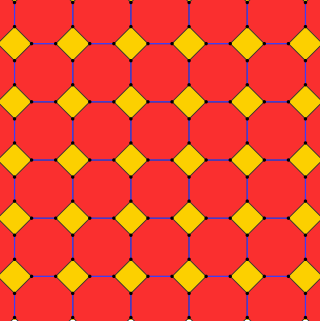
In geometry, the truncated square tiling is a semiregular tiling by regular polygons of the Euclidean plane with one square and two octagons on each vertex. This is the only edge-to-edge tiling by regular convex polygons which contains an octagon. It has Schläfli symbol of t{4,4}.

In geometry, the snub hexagonal tiling is a semiregular tiling of the Euclidean plane. There are four triangles and one hexagon on each vertex. It has Schläfli symbol sr{3,6}. The snub tetrahexagonal tiling is a related hyperbolic tiling with Schläfli symbol sr{4,6}.
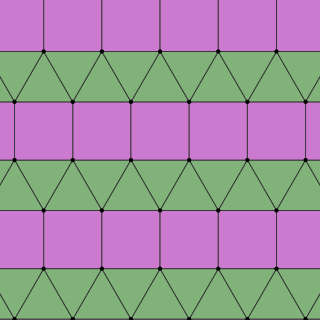
In geometry, the elongated triangular tiling is a semiregular tiling of the Euclidean plane. There are three triangles and two squares on each vertex. It is named as a triangular tiling elongated by rows of squares, and given Schläfli symbol {3,6}:e.

In geometry, the tetrapentagonal tiling is a uniform tiling of the hyperbolic plane. It has Schläfli symbol of t1{4,5} or r{4,5}.

In geometry, the snub octaoctagonal tiling is a uniform tiling of the hyperbolic plane. It has Schläfli symbol of sr{8,8}.

In geometry, the truncated order-3 apeirogonal tiling is a uniform tiling of the hyperbolic plane with a Schläfli symbol of t{∞,3}.

In geometry, the truncated infinite-order triangular tiling is a uniform tiling of the hyperbolic plane with a Schläfli symbol of t{3,∞}.

In geometry, the truncated triapeirogonal tiling is a uniform tiling of the hyperbolic plane with a Schläfli symbol of tr{∞,3}.

In geometry, the snub triapeirogonal tiling is a uniform tiling of the hyperbolic plane with a Schläfli symbol of sr{∞,3}.

In geometry, the infinite-order square tiling is a regular tiling of the hyperbolic plane. It has Schläfli symbol of {4,∞}. All vertices are ideal, located at "infinity", seen on the boundary of the Poincaré hyperbolic disk projection.
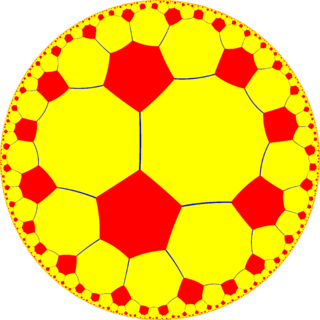
In geometry, the truncated order-6 pentagonal tiling is a uniform tiling of the hyperbolic plane. It has Schläfli symbol of t1,2{6,5}.

In geometry, the quarter order-6 square tiling is a uniform tiling of the hyperbolic plane. It has Schläfli symbol of q{4,6}. It is constructed from *3232 orbifold notation, and can be seen as a half symmetry of *443 and *662, and quarter symmetry of *642.
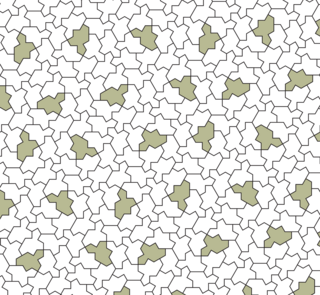
In plane geometry, the einstein problem asks about the existence of a single prototile that by itself forms an aperiodic set of prototiles; that is, a shape that can tessellate space but only in a nonperiodic way. Such a shape is called an einstein, a word play on ein Stein, German for "one stone".

Craig S. Kaplan is a Canadian computer scientist, mathematician, and mathematical artist. He is an editor of the Journal of Mathematics and the Arts, and an organizer of the Bridges Conference on mathematics and art. He is an associate professor of computer science at the University of Waterloo, Canada.

David Smith is an amateur mathematician and retired print technician from Bridlington, England, who is best known for his discoveries related to aperiodic monotiles that helped to solve the einstein problem.




















